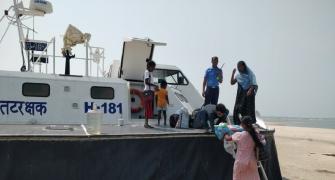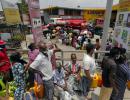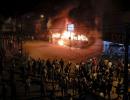The Sri Lankan government on Friday termed the violent demonstration near President Gotabaya Rajapaksa's residence over the current economic crises as 'an act of terrorism' and blamed 'extremist elements' linked to opposition parties for the incident.

A violent protest erupted outside the residence of Rajapaksa on Thursday as hundreds of demonstrators gathered there and demanded his resignation for what they called his failure in addressing the worst economic crisis in the island nation.
Several people were injured and vehicles were set on fire as the agitation turned violent.
Police fired tear gas and water cannons at the protesters after they pulled down a steel barricade placed near the president's residence.
Following the incident, several people were arrested and a curfew briefly imposed in most parts of Colombo city.
A foreign exchange crunch in Sri Lanka has led to a shortage of essential goods such as fuel. cooking gas, and power cuts that last up to 13 hours a day.
A statement issued by the presidential media division on Friday said an extremist group was behind the unrest near President Rajapaksa's residence in Mirihana, the Daily Mirror news website reported.
"It has been revealed that a group of organised extremists were protesting near the Jubilee Post in Nugegoda, suddenly became riotous and turned violent," the report said, citing the statement.
Many of those involved in the incident have been arrested and many have been found to have been organised extremists, the statement said.
Meanwhile, talking to reporters, transport minister Dilum Amunugama said the violence "was an act of terrorism".
Tourism minister Prasanna Ranatunga blamed 'extremist elements' linked to opposition parties Samagi Jana Balawegaya and Janatha Vimukthi Peramuna responsible for the violence.
Health minister Keheliya Rambukwella said the president's life was in danger as the demonstration had taken place due to intelligence failure.
Meanwhile, the police said the number of people arrested in the aftermath of the violence has increased to 54. Lawyers linked to opposition parties claimed that the police might charge those arrested under the draconian Prevention of Terrorism Act.
Five policemen were injured, while a police bus, a jeep and two motorcycles were burnt as protesters turned violent. The demonstrators also caused damage to a police water cannon truck.
A curfew, covering most parts of the Colombo district and the suburban police division of Kelaniya, imposed midnight following the agitation was lifted at 5 am on Friday.
In the Kelaniya area, protesters had blocked the main Colombo-Kandy road. From late Thursday evening, hundreds of people gathered at the Jubilee Post junction in the east Colombo suburb of Mirihana, holding placards against what they say was the mismanagement and inefficiency of the Rajapaksa government in handling the current economic crisis.
The numbers slowly swelled to several thousands as they started marching towards Rajapaksa's private residence at Pangiriwatte Lane, off the main road.
The police placed barricades preventing protesters from reaching the president's residence located in the middle part of the bylane. It is not known whether Rajapaksa was at his residence at that time.
Sri Lanka is currently experiencing its worst economic crisis in history. With long lines for fuel, cooking gas, essentials in short supply and long hours of power cuts the public has been suffering for weeks.
Rajapaksa has defended his government's actions, saying the foreign exchange crisis was not his making and the economic downturn was largely pandemic driven where the island's tourism revenue and inward remittances waning.








